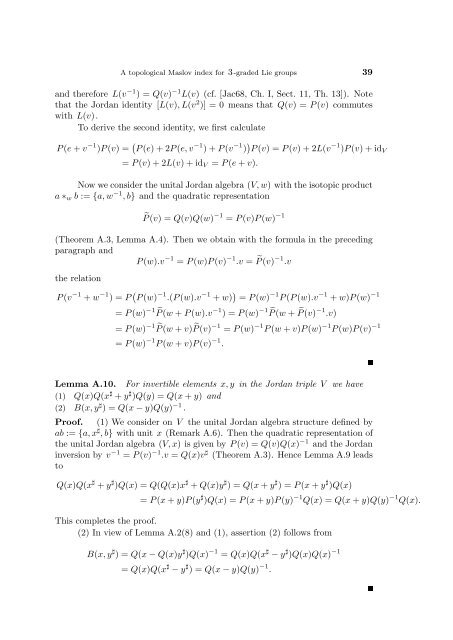A topological Maslov index for 3-graded Lie groups - ResearchGate
A topological Maslov index for 3-graded Lie groups - ResearchGate
A topological Maslov index for 3-graded Lie groups - ResearchGate
You also want an ePaper? Increase the reach of your titles
YUMPU automatically turns print PDFs into web optimized ePapers that Google loves.
A <strong>topological</strong> <strong>Maslov</strong> <strong>index</strong> <strong>for</strong> 3-<strong>graded</strong> <strong>Lie</strong> <strong>groups</strong> 39<br />
and there<strong>for</strong>e L(v −1 ) = Q(v) −1 L(v) (cf. [Jac68, Ch. I, Sect. 11, Th. 13]). Note<br />
that the Jordan identity [L(v), L(v 2 )] = 0 means that Q(v) = P(v) commutes<br />
with L(v).<br />
To derive the second identity, we first calculate<br />
P(e + v −1 )P(v) = P(e) + 2P(e, v −1 ) + P(v −1 ) P(v) = P(v) + 2L(v −1 )P(v) + idV<br />
= P(v) + 2L(v) + idV = P(e + v).<br />
Now we consider the unital Jordan algebra (V, w) with the isotopic product<br />
a ∗w b := {a, w −1 , b} and the quadratic representation<br />
P(v) = Q(v)Q(w) −1 = P(v)P(w) −1<br />
(Theorem A.3, Lemma A.4). Then we obtain with the <strong>for</strong>mula in the preceding<br />
paragraph and<br />
P(w).v −1 = P(w)P(v) −1 .v = P(v) −1 .v<br />
the relation<br />
P(v −1 + w −1 ) = P P(w) −1 .(P(w).v −1 + w) = P(w) −1 P(P(w).v −1 + w)P(w) −1<br />
= P(w) −1 P(w + P(w).v −1 ) = P(w) −1 P(w + P(v) −1 .v)<br />
= P(w) −1 P(w + v) P(v) −1 = P(w) −1 P(w + v)P(w) −1 P(w)P(v) −1<br />
= P(w) −1 P(w + v)P(v) −1 .<br />
Lemma A.10. For invertible elements x, y in the Jordan triple V we have<br />
(1) Q(x)Q(x ♯ + y ♯ )Q(y) = Q(x + y) and<br />
(2) B(x, y ♯ ) = Q(x − y)Q(y) −1 .<br />
Proof. (1) We consider on V the unital Jordan algebra structure defined by<br />
ab := {a, x ♯ , b} with unit x (Remark A.6). Then the quadratic representation of<br />
the unital Jordan algebra (V, x) is given by P(v) = Q(v)Q(x) −1 and the Jordan<br />
inversion by v −1 = P(v) −1 .v = Q(x)v ♯ (Theorem A.3). Hence Lemma A.9 leads<br />
to<br />
Q(x)Q(x ♯ + y ♯ )Q(x) = Q(Q(x)x ♯ + Q(x)y ♯ ) = Q(x + y ♯ ) = P(x + y ♯ )Q(x)<br />
= P(x + y)P(y ♯ )Q(x) = P(x + y)P(y) −1 Q(x) = Q(x + y)Q(y) −1 Q(x).<br />
This completes the proof.<br />
(2) In view of Lemma A.2(8) and (1), assertion (2) follows from<br />
B(x, y ♯ ) = Q(x − Q(x)y ♯ )Q(x) −1 = Q(x)Q(x ♯ − y ♯ )Q(x)Q(x) −1<br />
= Q(x)Q(x ♯ − y ♯ ) = Q(x − y)Q(y) −1 .

















